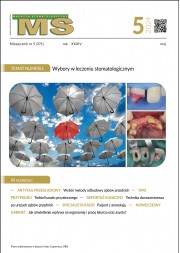Dostęp do tego artykułu jest płatny.
Zapraszamy do zakupu!
Po dokonaniu zakupu artykuł w postaci pliku PDF prześlemy bezpośrednio pod twój adres e-mail.
Evaluation of dental caries in children aged 4-5 years based on the literature and personal clinical studies
Próchnica zębów jest najbardziej rozpowszechnioną chorobą narządu żucia. Definiowana jest jako proces bakteryjny prowadzący do demineralizacji i rozpadu proteolitycznego tkanek twardych zęba. Próchnica w zębach mlecznych rozpoczyna się około pierwszego roku życia dziecka. Jej frekwencja próchnicy zwiększa się z wiekiem, u dzieci między 6. a 7. rokiem życia zbliża się do 100%. Największy wzrost frekwencji próchnicy u dzieci obserwuje się między 2. a 4. rokiem życia. Badania oceniające stan uzębienia mlecznego u dzieci w wieku 4-5 lat są niezbyt liczne.
Celem pracy była ocena stanu uzębienia mlecznego dzieci 4-5-letnich zgłaszających się do leczenia w Katedrze i Zakładzie Stomatologii Wieku Rozwojowego Uniwersytetu Medycznego w Lublinie, z uwzględnieniem metod leczenia.
Badaniem klinicznym objęto 167 dzieci w wieku 4-5 lat, 96 dziewcząt i 71 chłopców. Grupa 4-latków liczyła 101 dzieci, a 5-latków – 66 dzieci.
Oceniono frekwencję próchnicy zębów mlecznych; podstawą oceny stanu uzębienia była średnia liczba puwz i jej składowe; obliczono również wskaźnik leczenia (WL). Frekwencja próchnicy w całej badanej grupie wyniosła 73,12%, średnia liczba puw – 6,6. Wskaźnik leczenia dla całej grupy wynosił 0,07.
Najczęściej przeprowadzanym zabiegiem w obu grupach wiekowych była impregnacja zębów za pomocą azotanu srebra. Znacznie rzadziej wykonywano wypełnianie ubytków próchnicowych, remineralizację tkanek twardych zębów z użyciem preparatów fluorkowych i leczenie ozonem.
Stwierdzono wysoce niezadowalający stan uzębienia dzieci 4-5-letnich.
Dental caries is the most widespread disease of the chewing apparatus. It is defined as a bacterial process leading to demineralisation and proteolytic disintegration of the hard dental tissues. Caries in deciduous teeth starts about the first year of the child. The incidence of caries increases with age; in children between the 6th and 7th year of life it is close to 100%. The greatest increase in frequency of caries in children is seen between the 2nd and 4th year of life. (1). Studies evaluating the condition of the deciduous dentition in 4 to 5-year-olds are not numerous. The aim of the study was to determine the condition of the deciduous dentition in 4 to 5-year-olds presenting for treatment at the Chair and Department of Paediatric Dentistry at Lublin Medical University, taking into account the method of treatment. The clinical exam involved 167 children aged 4-5 years, 96 girls and 71 boys. The group of 4-year-olds had 101 children, and 5-year-olds – 66 children. Evaluations were made of caries incidence in deciduous teeth; the basis for evaluating the state of the dentition was the mean value of DMFT and its components; calculation was also made of the index of treatment needs (ITN). The incidence of caries in the whole group examined was 73.12%, mean dmf – 6.6. The index of treatment needs for the whole group was 0.07. The most frequently carried out procedure in both age groups was the impregnation of teeth with silver nitrate. Significantly less frequent were the procedures of filling of carious cavities, the remineralisation of the hard dental tissues with the use fluoride preparations and ozone treatment. There was found to be a highly unsatisfactory state of the dentition in 4 to 5-year-olds.













